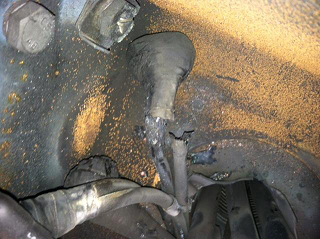What is a high resistance connection?
A lot of words come to mind when the term “high resistance connection” is used, though reliability is not one of them.
A lot of words come to mind when the term “high resistance connection” is used, though reliability is not one of them. Loose, poor, heat, imbalance, and failure are a few often associated with high resistance connection, and for good reason. They are often the root cause of motor failures.
According to IEEE, “a high-resistance (R) connection in an induction-motor electrical circuit results in localized overheating and supply-voltage unbalance, which leads to a decreased efficiency and reliability and an increased fire hazard in the electrical distribution system and motor”.
You can find them at circuit breakers, motor starter terminals, disconnects, or anywhere on the power circuit where a connection is made. The focus of today’s topic is the motor lead connections, which, done improperly, often lead to failure.
According to Noah Bethel of PdMA, a project conducted in 1994 on industrial power distribution systems “found that connectors and conductors were the source of 46 percent of the faults reducing motor efficiency”. Noah went on to write in an article in Reliable Plant that:
- Many times a motor, although initially in perfect health, is installed into a faulty power circuit, with a high resistance connection for example.
- High resistance connections result in voltage imbalances will reduce the horsepower rating significantly.
- As these problems become more severe, motor temperatures increase and insulation damage begins.
- This motor is replaced many times and the failure cycle begins again.
How can you detect a high resistance connection?
Per the previously mentioned article by IEEE, “it is important to monitor and correct high-R connections for a reliable, efficient, and safe operation of the industrial facility”. Many maintenance teams will occasionally test motor resistance to ground with a megohmmeter. This test is often misapplied, as it is easily misunderstood what minimum insulation requirements should be and that these readings must be temperature compensated. We will cover than in another post. However, you have to go beyond basic insulation resistance testing to catch high resistance connections.
A good method of finding high resistance connections is to measure the phase-to-phase resistance between each of the three windings (in a three-phase motor). This would result in three measurements that should be very close (balanced) to each other. You can do it in the field with a low ohm resistance meter.
As a word of caution, a high resistance connection usually develops over time. Therefore, it is more effective to conduct these tests periodically and examine trends. This sounds complicated, but PdMA analyzers make it relatively simple, and combine many other effective tests into the same piece of equipment. Starting a regular, disciplined testing program with documented trends is a very effective deterrent to premature failure caused by high resistance connections.
In the example below, we were conducting testing as part of a program for a power generation station in North Carolina. This high resistance connection was found during a down day. As shown on the screen capture from the PdMA, the test equipment is identifying the resistive imbalance, change in insulation resistance, and several other alarm issues. While this looks like an easy failure to capture, the motor was actually running the day before and would have been returned to operation had the testing not occurred.

An actual high resistance connection found on a motor in operation.

How can you prevent high resistance connections?
This power station runs continuously, and so the high resistance connection slowly “burned out” overtime. Their maintenance team had the good foresight to implement a testing program, which ultimately saved this motor winding.
How can you prevent high resistance connections?
As stated in an earlier post, we have found that bolted lugs, such as Color Key by T&B, make for the most reliable and practical connections. For more on that, see our previous post on reliable motor connections.
Insulate them with quality tapes, such as those provided by 3M. To be sure that you are providing the correct combination and layers of tapes for the rated voltage, check out our post on insulating connections.










